Brown Mottlegill
One of the commonest ‘Little Brown Mushrooms’ or LBMs, growing on any kind of grassy areas. Extremely variable by its colour, which makes it not too easy to identify without microscopy.
| Mushroom Type | |
| Common Names | Brown Mottlegill (UK), Lawn Mower's Mushroom (US), Mower's Mushroom (US), Haymaker (US), Medelwr (CY), Kołpaczek Szorstkozarodnikowy (PL), Réti Trágyagombácska (HU) |
| Scientific Name | Panaeolina foenisecii |
| Synonyms | Psathyrella foenisecii, Panaeolus foenisecii, Psilocybe foenisecii |
| Season Start | Apr |
| Season End | Dec |
| Average Mushroom height (CM) | 3–7 |
| Average Cap width (CM) | 1–3 |
Cap
1–3 cm across, hemispherical to bell-shaped (campanulate), looks very different when moist and when dried (hygrophanous). The cap is medium to dark reddish brown when wet, could be beige to almost white when dry, it dries from the centre towards the edge of the cap.
Gills
Broadly attached to the stem (adnate), pale brown at first, then covered with dark brown dots, hence the name: Mottlegill. The edge of the gills remain paler.
Stem
3–7 cm tall, 1–2 mm wide. Cylindrical, often slightly curvy, hollow. Smooth, shiny cream-white, flushed with mid-brown towards the base, covered with a bloom (pruinose) at the apex.
Habitat
Saprotrophic on soil. Growing on any sort of grassy areas, such as lawns, turfs, gardens, parklands, arboretums, cemeteries, commons, etc., where it fruits in groups.
Possible Confusion
There are many LBMs or ‘Little Brown Mushrooms’ with rather similar size, shape and habitat, but it can be most of all confused with other small size mottlegills.
Turf Mottlegill (Panaeolus fimicola) shares its habitat with Brown Mottlegill, however, it fruits a bit earlier and it is slightly larger. It has rather similar coloured cap and stem too, but the edge of its gills are white and its spores are red-brown in Melzer’s reagent (under microscope).
Dewdrop Mottlegill (Panaeolus acuminatus) is similar in size and grows on the same habitat as Brown Mottlegill, however it has black spores, the gills mottled with black and becoming entirely black with maturation, but the easiest way to separate the two species is to check the gills in wet weather. Dewdrop Mottlegill often have water droplets on/around the gills which turns black because of the spores, hence its common name.
Banded Mottlegill (Panaeolus cinctulus) is growing out of cow or horse manure (incl. middens). It is slightly bigger than Dewdrop Mottlegill, and it is more reddish-brown than its relative. According to D. Arora, it contains psilocybin which – if it is a correct info – makes it as a Class A drug in the UK, however, this information cannot be confirmed by UK authors.
Spore Print
Spore print is dark brown. Spores are ellipsoid to almond-shaped (amygdaliform), warty, thick-walled with a germ pore.
Taste / Smell
Inedible. Taste and smell indistinctive.
Frequency
Very common and widespread in the UK, probably one of the commonest LBMs.
Other Facts
There are some hearsay about its (neuro)toxicity, but it might be based on one of its former name, Psilocybe foenisecii. However, there is no evidence about the presence of psilocybin in this species, even in traces. It is also possible that it was confused with one of its toxic lookalikes.
There are some reports about it might be toxic to children if consumed in large enough quantities, but eating raw mushrooms may lead to gastrointestinal symptoms even if the mushroom itself is not toxic at all, so we stick to the international (European) classification and consider this species as inedible only.


 (5 votes, average: 4.00 out of 5)
(5 votes, average: 4.00 out of 5)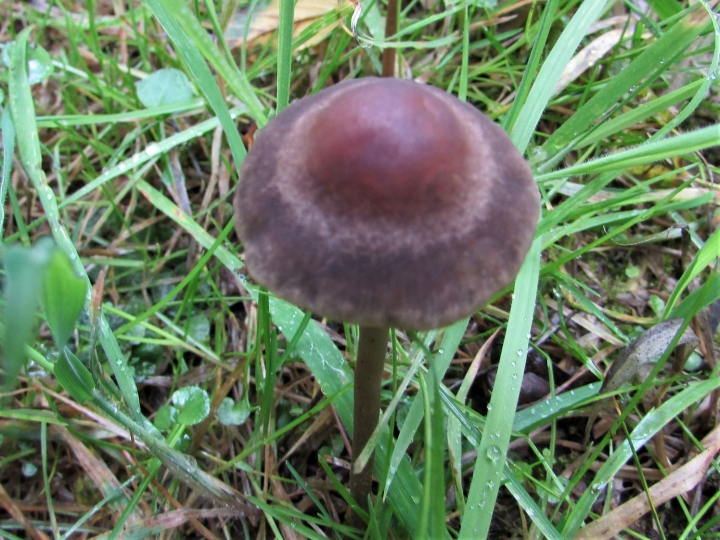
















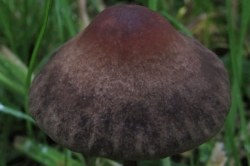
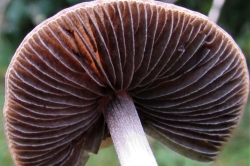
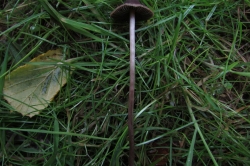
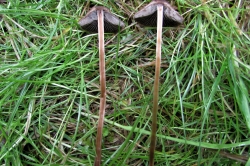
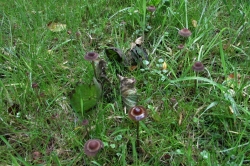





1 comment for Brown Mottlegill
Found some of these last week and thought they were a Liberty Cap until I came here to this site and realised they were mere mottlegills.
Similar coloured cap to the LC and a little umbo too, but it was missing the purple gills and the translucent cap-cover. Not to mention the stem on a mottlegill isn’t wavy like a LC’s.